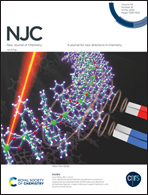Amorphous calcium organophosphate nanoshells as potential carriers for drug delivery to Ca2+-enriched surfaces†
Abstract
A highly selective nanocarrier for targeted drug transport and delivery to calcium-containing surfaces, as a bone mineral matrix, is described. The nanocarrier, a calcium phosphate (CaP) nanoshell, is capable of interacting with calcium ions contained in enriched surfaces (Ca2+ modified mica surface, hydroxyapatite nanoparticle (Ap) films on glass, and Ap modified 45S5® bioactive glass-based scaffolds) with the consequent disruption of the inorganic structure and release of (bio) molecules contained in the interior. The antibiotic Levofloxacin (LX) was used as a model drug for encapsulation and drug release studies which allowed monitoring by fluorescence spectroscopic methods. The accumulation and disruption of CaP nanoshells triggered by calcium ions over surfaces were followed by microscopy techniques such as SEM, AFM, and fluorescence microscopy. Bacterial susceptibility and time killing assays demonstrated the bactericidal potential of the nanoshells containing LX. A mechanism for the Ca2+-activated CaP nanoshell accumulation and drug release is proposed and discussed.



 Please wait while we load your content...
Please wait while we load your content...